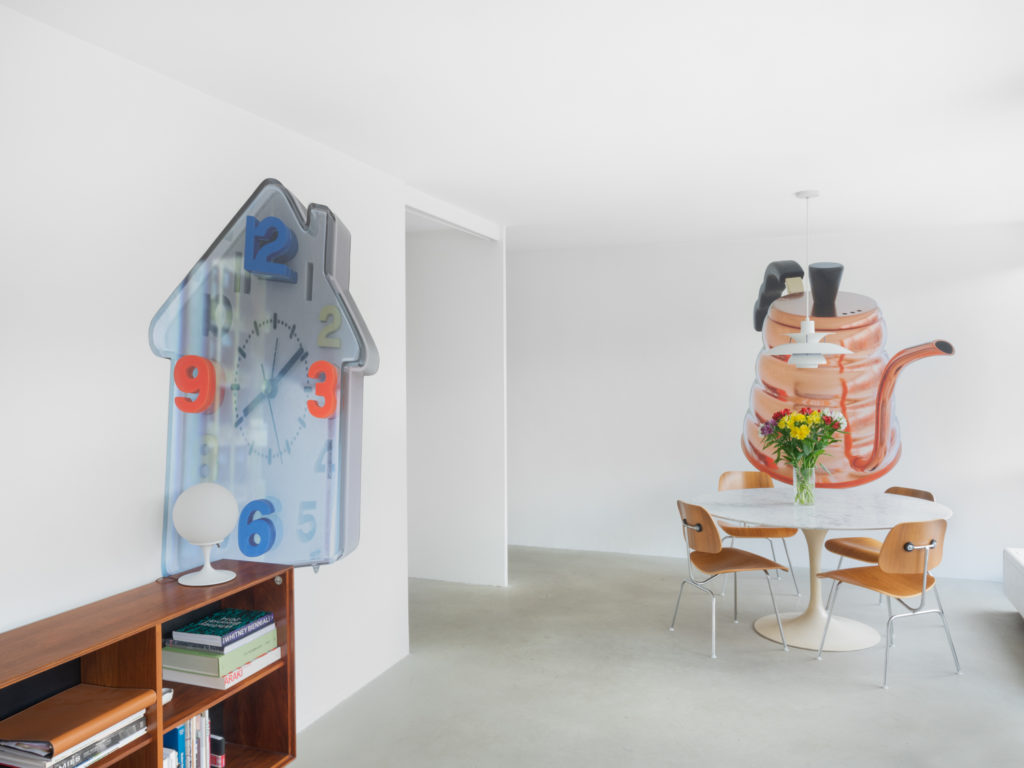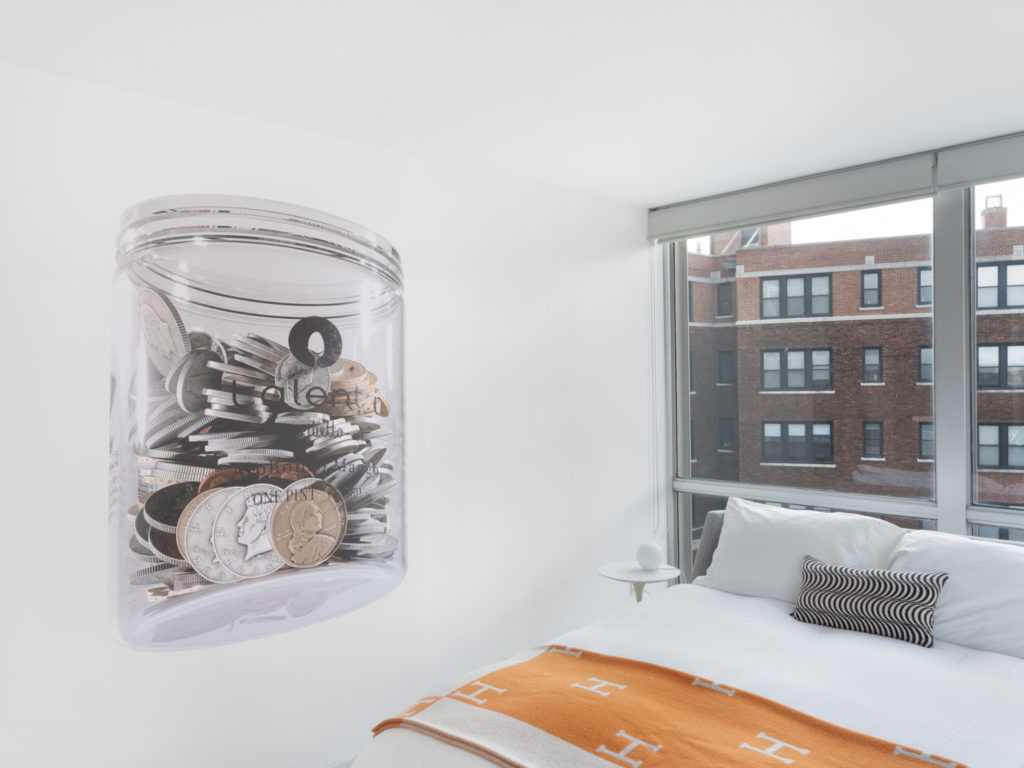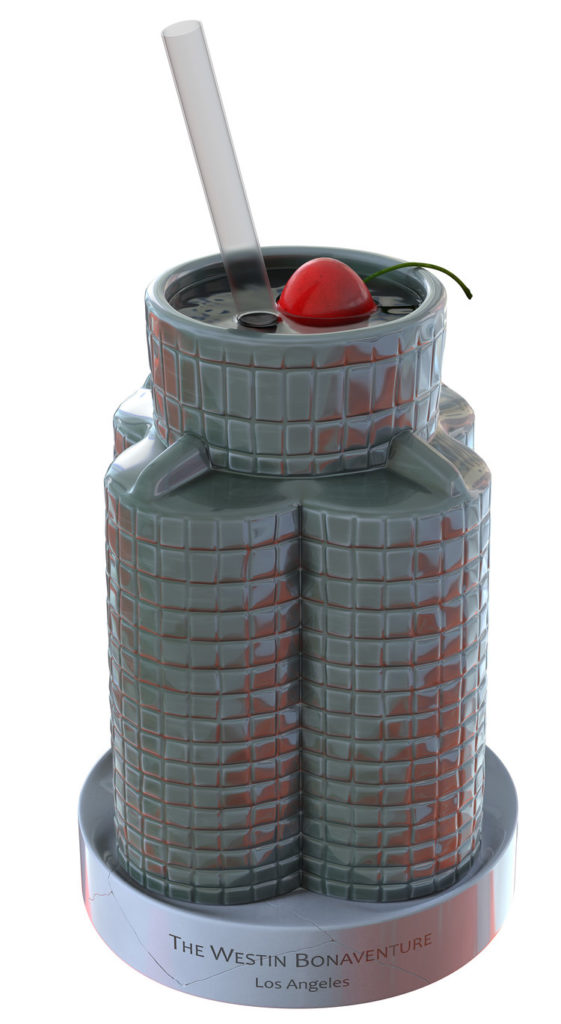Asha Schecter: Shane Campbell Lincoln Park
by Jacob Stewart-Halevy

In 1963, the artists Konrad Lueg and Gerhard Richter sat on brown woolen couches beneath kitsch paintings in a furniture store in Düsseldorf. Pretending to be bored watching television, they were Living with Pop, or at least making fun of those who did. The performance was an important moment in postwar art. Pop seemed to edify mass consumption, but here it was directed against advertisers, industrial designers, and middle-class homeowners who needed to furnish their mid-century modern apartments, high-rises like the one Ludwig Mies van der Rohe designed that year at 2400 North Lakeview Avenue in Chicago.
Fast forward over a half-century later and those Mies units, easy abstractions, and clean line sofas have become burnished with the veneer of historical importance, especially in jazzy places like Chicago and Los Angeles where High Modernism quickly became a matter of View-Masters and terrazzo tiles. Over the past decade, art galleries colonized refurbished Mies, Neutra, Schindler, Johnson, and Breuer buildings, which proved to be serviceable staging interiors, especially for the kind of online viewing that translates into ecommerce. When Shane Campbell expanded to Lakeview, the gallery tended to exhibit Los Angeles-based sculptors and painters who channeled the Cool School (read: hard-edged and process-based abstraction alongside the occasional painting of a Monstera Deliciosa house plant). The retro-choice was a safe bet and looked great with the view.
When the LA-based Asha Schechter showed there this fall, he found himself in a sticky situation therefore. Although of the same generation as the others, he was not exactly a member of the gallery’s Monstera Roster. Like the Independent Group and Capitalist Realist strands of Pop before him, Schechter needed to contain and display the leisurely lifestyles associated with the art of his peers without pissing them off or becoming a token of their type. The exhibition is significant therefore because he or the gallery seem to transition from tasty art to art about taste. Perhaps this is why Schechter has chosen to show stickers rather than photographs, which of course can be wall-mounted, but may be easily torn off or reproduced at the discretion of the collector.
In the apartment, we find five of these wall adhesives. New images of common objects, all containers of some sort: a Talenti gelato pint filled with quarters, a house-shaped plastic kids-room clock, a cocktail mug of the Westin-Bonaventure Hotel, a Beverly Hills Juice tote-bag, and an ergonomic copper tea kettle. The stickers seem to be the sort used on busses, subways, and retail windows. Some are placed slightly askew and others look as if they are popping out from behind the furniture. Plus they are so big—blown up way out of proportion to three or four feet, the adhesives become trompe l’oeil sight-gags. This is confirmed by a closer look where, low and behold, a Sacajawea coin sits among the quarters, a mosquito rests on the tote bag, and a fly has died, smothered in the Plexiglas clock.

Poor fly—trapped in its container, much like the other apartment dwellers at Lakeview. A whole generation of yuppies—the greatest generation!—seem to have managed to spend their entire lives in glass and steel complexes like this one. Their children who once drooled on the credenzas are grown up, dutifully doting on their geriatric parents who wheeze through the poor ventilation, suffocating slowly. A life well packaged, too well perhaps.
Maybe that explains the container theme; It is hard to say. In some pat sense the stickers seem to be about leasing brands through diffusion products: you may have eaten the gelato, but you can keep the Talenti container; you drank the juice, now carry the tote; you visited the rotating cocktail bar at the Bonaventure, here’s a souvenir of the building. Commodity fetishism and consumer desire are prompted by the miniature. If this is where we are headed, I am yawning and would just rather fall asleep in the apartment gallery bedroom, which looks really comfortable. Instead I want to know just what is it that makes this art about today’s (or yesterday’s?) homes so different, so appealing? Or unappealing, or whatever.
Perhaps the show’s title offers answers: people who live in glass houses love it! Schechter ripped it from a realty ad for the building, which of course borrows from the proverb about not casting stones. If he had used the original, it would have signaled something about how difficult it is to make art while working with members of the establishment in these regional capitals. They are in a fragile spot to be honest, maintaining a tenuous hold on the collector base and eternally preoccupied with status with respect to the center, which inevitably leads to intransigency.

But Schechter is not trying to throw stones here and that is not the title. Rather, “people who live in glass houses love it!” points to a new kind of ownership, which might be leading to a new kind of Pop, namely, the ownership over social-reflexivity. Today you see it everywhere. People proudly adopt and play with the profiles, hashtags and pigeonholes designed for them. They seem to know where they stand and love to own it. But nasty women headbands, deplorables trucker hats, and “Kiss Me I’m Irish” t-shirts are all a little uncouth and déclassé. They are certainly not the kinds of things worn around Lakeview are they? Schechter seems to ask what happens when these forms of social reflexivity make their way into the communicative and consumption practices of the contemporary art world. Can we imagine the slogan, “We, William-Sonomans?” Are we willing to wear our choices on our sleeves or walls even? Would we buy a pricey sticker to prove it? I guess that is the challenge—to see if it passes the wall test or just peels off.
Asha Schechter’s people who live in glass houses love it! runs at Shane Campbell Gallery, Lincoln Park until January 18, 2019.